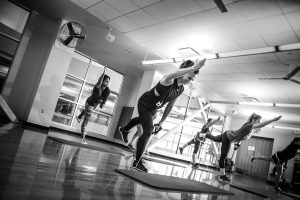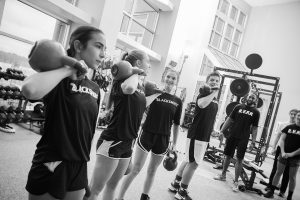My Balance Sucks!
Balance is a word thrown out a lot. You need balance in your life. Balance in your nutrition. Balance in training. All phenomenal blog post topics, but the purpose of this blog is simply to talk about the “balance” while actually performing an exercise!
There is nothing more frustrating than feeling 100% physically capable of moving the weight or doing the exercise, but you feel like an upside down bobble head in a car driving over rumble strips. Even worse is if you are starting to get back on the exercise train, you’re already nervous and embarrassed, the instructor is talking super fast and everyone else knows what they’re doing, and you can’t even step forward without risking needing stitches.
What is balance?
An even distribution of weight enabling someone or something to remain upright and steady.
Why does mine suck?
It could be a wide variety of reasons too deep to get into here. Joint instability, improper mobility, strength imbalances, overweight, underweight, menopause, or a super bad hangover from the night before.
Some of us are naturally born with poor balance (thanks mom!). The older we get, our balance gets worse…. WRONG. It actually has a lot more to do with improper training. Yes, there are some crazy scientific things going on in your brain and ears as you age that make it more difficult, but its actually not an excuse.

OK cool, how do I fix it?
The studies are very torn here. Can it be trained? Yes and No. Depends on your goals and what you’re training for! Balance and proprioception are SKILL SPECIFIC. There is a difference between static balance (standing on one leg) and dynamic balance (doing a forward lunge).
Studies would imply that you should put the body/ankle/etc in skill specific positions for it to then adapt to… but that becomes an issue. When training the elderly, should we then try to simulate every kind of fall that is possible? Of course not. In a study by Bruhn et al., a high-intensity strength training group actually outperformed the unstable surface training (static balance training) group on measures of static balance (4). In other words, one group trained static balance, and the other didn’t – and the one who didn’t train static balance directly actually improved the most overall. Maybe muscle cross-sectional area played into it? Maybe it occurred because of increased stabilization via enhanced intra- and intermuscular coordination that would allow for more rapid and effective force production (strength and rate of force development)? Maybe true specificity isn’t as important as we thought?
Calm down Justin. Lots of big words there. Spark notes appreciated.
- GET STRONG
- Using a kettlebell or dumbbell doesn’t qualify for ‘strength’. To be honest, anything over 12 reps isn’t strength. It’s all smoke and mirrors. Even class descriptions notate strength, but aren’t actually strength. Exercise is a business, strength is a fun word, so they lie to you.
- 3 sets of 6-10 repetitions with a weight so heavy you absolutely could NOT perform 12 repetitions. That’s literally the only way to train strength.
- MODIFY!
- If it’s a single leg exercise, make it double leg!
- There isn’t really a huge difference here. You’ll need heavier weight to still build strength than you would with single leg. But your muscles don’t really know the difference.
- Find an Anchor!
- Use a wall, a band, a partner, or just stare at a spot on the floor NOT moving, and it will help a ton.
- Change the weight location
- Holding the weight on your back, holding it in front, or holding it between your legs can often help.
- Go barefoot!
- Sorry, the easiest solution isn’t technically allowed on the fitness floor or group exercise gyms for safety reasons, but it is allowed in the training studio or at home.
- Remember skill specific!
- If split squats and single leg RDL’s are a balance nightmare, do them more often! Don’t fully avoid them.
- Modify during the class so you can build up a ton of strength, then practice them at home with your new found strength!
- If it’s a single leg exercise, make it double leg!

References 1. DROWATZKY, J.N., AND F.C. ZUCCATO. Interrelationships between selected measures of static and dynamic balance. Res. Q. 38:(3) 509-510. 1966. 2. TSIGILIS, N., E. ZACHOPOULOU, T. MAVRIDIS. Evaluation of the specificity of selected dynamic balance tests. Percept Mot Skills. 92(3 Pt 1):827-33. 2001. 3. KONRADSEN, L. Factors Contributing to Chronic Ankle Instability: Kinesthesia and Joint Position Sense. J Athl Train. 37(4):381-385. 2002. 4. BRUHN, S., N. KULLMANN, AND A. GOLLHOFER. The effects of a sensorimotor training and a strength training on postural stabilisation, maximum isometric contraction and jump performance. Int J Sports Med. 25(1):56-60. 2004.
–
For more information on our private, small group, and semi private options go here! To experience all of our training options, ask the front desk about a 30 day experience!
Don’t forget to follow us on social media for live content, videos, tips, and tricks!
 RiverPlex
RiverPlex
![]() @PeoriaRiverPlex
@PeoriaRiverPlex
![]() peoriariverplex
peoriariverplex
